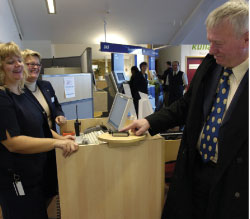
SAS passengers taking domestic flights within Scandanavia are now familiar with the option of being able to check-in at the airport with a scan of their index finger – a step up from using traditional forms of ID that is still commonly used as a security process across airports.
While passengers with baggage have been able to choose how they check-in, 98% of customers have so far preferred the biometric solution – a statistic that SAS airport self-service manager Helena Tranaeus-Bonnedahl is proud of. “In an industry that is so used to dealing with increased security regulations, it is really good to have found a solution that is good for the airline and good for the passengers, because they have approved it. Passengers are very positive and the feedback we’re getting is that they think it is a way of helping to achieve a smoother and easier way of travelling,” she said.
SAS developed the fingerprint technology with Precise Solutions in response to increased EU security regulations, stipulating that airlines must verify that a passenger travelling with baggage boards the plane.
The baggage kiosk is the first port of call for the customer choosing the biometric option. After choosing how many pieces of baggage they have, the kiosk prints off the required number of baggage tags. The passenger then takes the luggage to the baggage drop, where they place their index finger into a fingerprint reader. The baggage tags are then scanned and attached to the bags, to confirm that they belong to the passenger.
This was not the only advanced security measure to be tested by the airline. “We had trialled iris and fingerprint check-in, but we found that the fingerprint process went more smoothly than the iris scan and was more user friendly,” said Tranaeus-Bonnedahl. “The system is stable and everything has gone well – and we can’t see why we shouldn’t implement it across international flights in the future.”
Following its success, the airline is also planning to expand its biometric solution across the international market.






